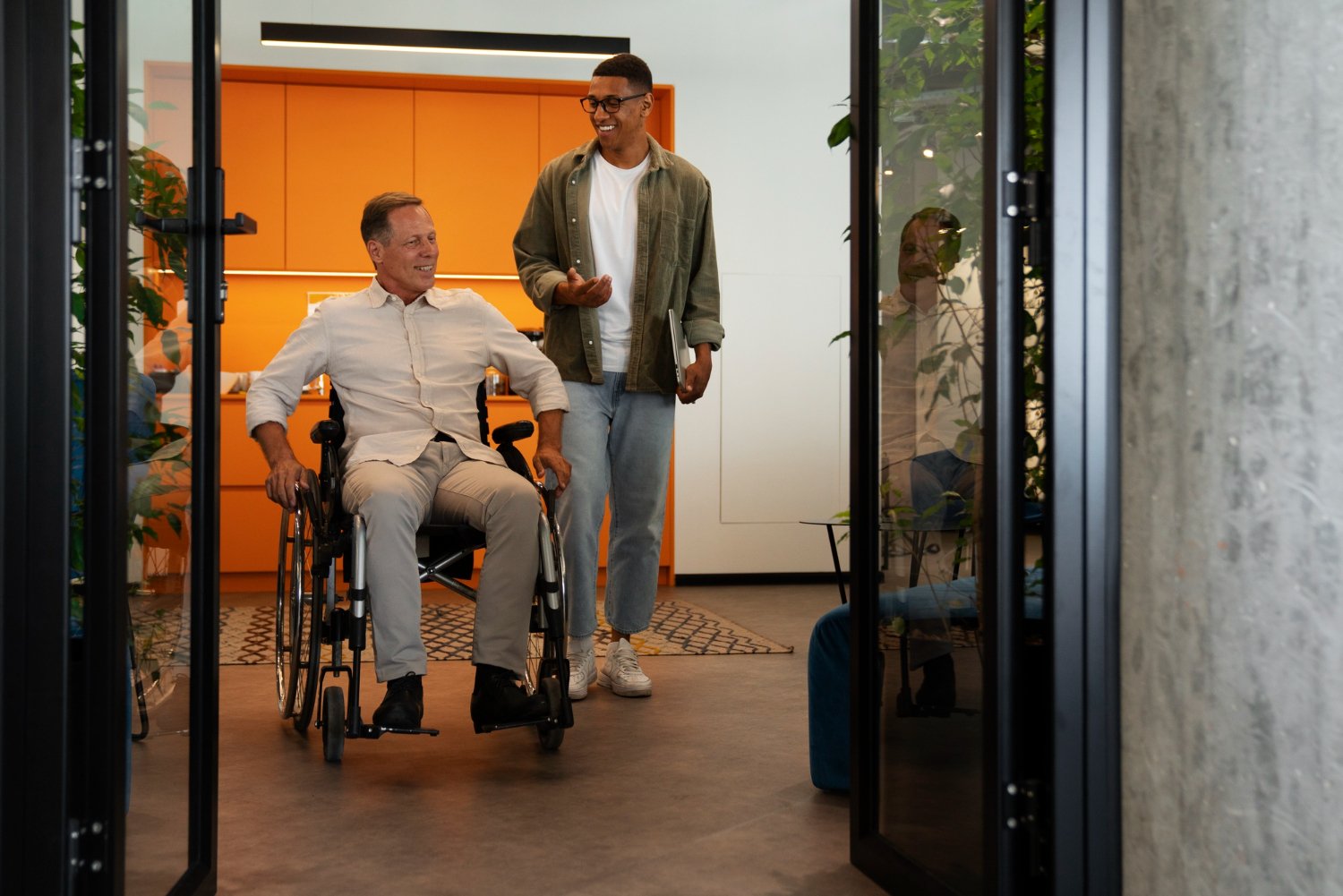
Why ADA Compliance Matters in Commercial Construction
The Importance of Accessibility in Public and Commercial Spaces
Accessibility is more than just a building requirement—it’s a reflection of inclusive design. Since the passage of the Americans with Disabilities Act of 1990, every commercial construction project must ensure that individuals with mobility challenges, including wheelchair users, can navigate spaces safely and independently. ADA compliant commercial doors are at the forefront of this effort, serving as gateways to offices, bathrooms, retail spaces, and more.
Beyond basic entry, proper design and construction of commercial doors improve usability for all occupants. Features such as low-effort door handles, lever-style latches, and smooth hinge operation are essential not only for accessibility but also for creating a safer, more functional built environment.
Legal Implications of Non-Compliance (Lawsuits, Fines, Project Delays)
Ignoring ADA accessibility standards carries serious risks. Failure to install ADA compliant doors can lead to costly lawsuits, government penalties, failed inspection reports, and project delays. A single audit of a commercial building that finds improper clearances, incorrect latch heights, or non-compliant thresholds can halt occupancy permits until issues are resolved.
Contractors must also account for evolving state and federal law that ties into accessibility. In states like Florida, ADA compliance integrates with building code requirements, making it a critical checkpoint in project planning and execution.
How ADA Standards Enhance Inclusivity and Usability for All
Compliant doors aren’t just about avoiding penalties—they improve daily life. Features such as properly mounted door closers that control pressure, lever-style locks and handles, and even automatic door sensors allow everyone—from employees to visitors—to access spaces independently.
In modern commercial spaces, ADA-compliant entryways also integrate seamlessly with access control systems and adjacent circulation spaces, ensuring a consistent accessibility experience. When applied thoughtfully, ADA standards don’t just meet minimum code—they create environments that foster productivity, safety, and dignity for every occupant.
Key ADA Requirements for Commercial Doors
Clear Width and Maneuvering Space
One of the most important requirements is the clear opening width. According to ADA standards, commercial doors must provide at least 32 inches of clear passage when the door is open 90 degrees. This allows enough space for a wheelchair or mobility aid to pass comfortably. Contractors must also plan maneuvering clearance on both the push and pull sides of the door, particularly in corridors or rooms with limited space.
Door Hardware Requirements
Hardware plays a pivotal role in compliance. Door handles, latches, and locks must be operable with one hand and without tight grasping, pinching, or twisting. Lever-style handles are the standard for ADA compliance, as they are easier to use than knobs. Additionally, the mounting height of all hardware—including hinges—must fall within a prescribed range to ensure accessibility.
Force and Speed of Door Operation
The door closer and opening mechanism must comply with specific force requirements. For interior commercial doors, the opening force should not exceed 5 pounds of pressure, while closing speeds must allow adequate time for safe passage. Automatic doors and sliding doors equipped with sensors are often installed in high-traffic areas like bathrooms, retail entries, or lobbies to enhance both compliance and convenience.
Thresholds and Floor Surfaces
Thresholds must not exceed ½ inch in height for most commercial interior openings. This ensures safe passage for wheelchair users and prevents tripping hazards. Smooth, slip-resistant surfaces at entries, including transitions near bathroom or corridor doors, further support both safety and accessibility.
Types of ADA Compliant Commercial Doors
Hollow Metal and Steel Doors
Hollow metal and steel doors are a staple in commercial settings due to their durability, fire-rated performance, and ease of maintenance. When fabricated to ADA standards, these doors provide the strength required for construction projects in schools, hospitals, and government facilities while meeting all accessibility codes.
Solid Core Wood Doors
For interiors where aesthetics and warmth matter—such as conference rooms or private offices—solid core wood doors are a reliable ADA-compliant option. They also offer excellent acoustic control, enhancing productivity in workplaces that demand sound separation. Properly installed hinges and compliant hardware make them both beautiful and functional.
Automatic and Power-Assisted Doors
In high-traffic commercial areas such as lobbies, retail spaces, and bathrooms, doors can be prepped for automatic operators and sensors. These operator systems reduce the physical effort required to use the door, making them ideal for individuals with limited mobility or strength. Power-assisted doors are another option—these reduce the pressure needed to push or pull, while still functioning as a standard swing door when necessary. Both options enhance safety, usability, and compliance with ADA standards.
Specialty ADA Door Solutions
Some environments demand specialty solutions. For example, sliding doors provide wider clearances and reduce swing-space requirements in tight corridors. custom fabricated ADA doors can include vision panel preps for visibility, integrated access control features, or reinforced locks for security-sensitive areas. Specialty ADA doors balance strict compliance requirements with the practical needs of modern commercial buildings.
Common Mistakes Contractors Make with ADA Doors
Installing Hardware at Non-Compliant Heights
One of the most frequent mistakes is placing door handles, latches, or locks outside ADA’s required height range. All operable parts must be mounted between 34 and 48 inches from the finished floor. Anything outside this range may cause a failed inspection and require reinstallation.
Using Thresholds That Are Too High
Thresholds above ½ inch create tripping hazards and prevent wheelchair users from entering smoothly. In addition to being unsafe, they violate ADA requirements and can create costly construction delays if corrections are needed after a code audit.
Overlooking Maneuvering Clearances in Tight Spaces
In busy commercial spaces like bathrooms, conference rooms, or corridors, contractors sometimes forget to allow adequate maneuvering clearance. Without enough space for a wheelchair to approach, push, or pull the door, the opening will fail compliance—even if the door itself is technically ADA compliant.
Mills & Nebraska: Providing ADA Compliant Door Solutions
In-House Fabrication for ADA Standards
At Mills & Nebraska, every ADA-compliant door solution is fabricated in-house to ensure strict adherence to federal and state standards. Their team accounts for clearances, hinge placement, door closers, and hardware prep to deliver job-site-ready assemblies.
Local Inventory and Fast Delivery
With a strong warehouse inventory of hollow metal, steel, and solid core wood doors, Mills & Nebraska provides contractors with quick access to ADA-compliant solutions. Whether it’s a bathroom, office, or secure facility, they ensure materials are delivered promptly to keep projects on schedule.
Support for Code Compliance
From design and construction planning to final inspection, Mills & Nebraska supports contractors, architects, and facility managers with expert guidance. Their knowledge of ADA accessibility, UL ratings, and Florida Building Code ensures every commercial project passes compliance with confidence.
Conclusion: Building Accessibility into Every Project
ADA compliant commercial doors are not just a regulatory requirement—they are a commitment to safety, inclusivity, and professional design. Whether it’s ensuring proper door closers, accessible handles, or doors that can be prepped for automatic sensors, the details matter. By planning for accessibility early, contractors avoid delays, pass inspections, and deliver buildings that serve all occupants equally.
Upgrade Your Project with ADA Compliant Doors from Mills & Nebraska
If your next project requires ADA compliant doors, Mills & Nebraska offers expert support, local inventory, and precision fabrication to help you succeed.
Their team provides end-to-end service—from quoting and fabrication to code guidance and fast delivery.
Contact Mills & Nebraska today to request a quote, explore options, and partner with ADA compliance experts who understand Florida’s commercial building needs.
FAQs (Frequently Asked Questions)
What makes a commercial door ADA compliant?
A commercial door must meet standards for width, clearance, hardware operability, door closer pressure, and threshold height. These features ensure safe and independent access for all occupants, including those using wheelchairs.
Do all office doors need to be ADA compliant?
Not every single interior door must be ADA compliant, but all public and common use areas in commercial buildings must provide accessible routes. This includes entrances, restrooms, conference rooms, and pathways between major areas.
Can fire-rated doors also meet ADA requirements?
Yes. Fire-rated hollow metal, steel, and solid core wood doors can be fabricated to meet both ADA and fire safety requirements. Proper hardware selection and compliant hinge prep ensure they satisfy both standards.
What types of hardware are required for ADA doors?
Lever handles, push/pull bars, and operable parts that don’t require tight grasping, pinching, or twisting are standard. ADA doors may also integrate with access control, electronic locks, and automatic door operators for added functionality.
How can Mills & Nebraska help ensure ADA compliance in my project?
Mills & Nebraska provides in-house fabrication, hardware prep, and expert consultation. They deliver prepped, labeled, and compliant door packages—complete with locks, closers, and accessories—ensuring every project meets ADA, UL, and Florida Building Code requirements.
.jpg)
.png)



